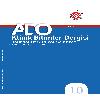Yağmur Suyu Hasat Potansiyelinin Belirlenmesi: Ege Üniversitesi Merkez Yerleşkesi Örneği
Kampüs, Ege Üniversitesi, Yağmur Suyu Hasadı
Determination of Rainwater Harvesting Potential: A Case Study from Ege University
Campus Ege University, Rainwater Harvesting, Irrigation,
___
- Almeida AP, Liberalesso T, Silva CM, Sousa V (2021) Dynamic modelling of rainwater harvesting with green roofs in university buildings. Journal of Cleaner Production 312(2021): 1-16. https://doi.org/10.1016/j.jclepro.2021.127655
- Bayramoğlu E, Büyükkurt U (2020) Water savings in sustainable campuses: Example of KTU Kanuni Campus. Online Journal of Art and Design 8(4): 347-353. http://www.adjournal.net/articles/84/8420.pdf
- Biswas BK, Mandal BH (2014) Construction and evaluation of rainwater harvesting system for domestic use in a remote and rural area of Khulna, Bangladesh. International Scholarly Research Notices 2014: 1-6. https://doi.org/10.1155/2014/751952
- Doorn N, Brackel L, Vermeulen S (2021) Distributing responsibilities for climate adaptation: Examples from the water domain. Sustainability 13(7) 3676: 1-16. https://doi.org/10.3390/su13073676
- Eren B, Aygün A, Likos S, Damar Aİ (2016) Yağmur suyu hasadı: Sakarya Üniversitesi Esentepe Kampüs örneği. Proceedings of the 4th International Symposium on Innovative Technologies in Engineering and Science, Antalya (Turkey), 487-494. https://www.isites.info/PastConferences/ISITES2016/ISITES2016/papers/A18-ISITES2016ID66.pdf
- ESRI (2022) World imagery [Basemap] Update date: 24 February 2022. https://www.arcgis.com/home/item.html?id=10df2279f9684e4a9f6a7f08febac2a9. Accessed 02 February, 2022.
- Farreny R, Morales-Pinzón T, Guisasola A, Tayà C, Rieradevall J, Gabarrell X (2011) Roof selection for rainwater harvesting: Quantity and quality assessments in Spain. Water Research 45(10): 3245-3254. https://doi.org/10.1016/j.watres.2011.03.036
- Gould J, Nissen–Petersen E (1999) Rainwater Catchment Systems for Domestic Supply – Design, Construction and Implementation. ITDG Publishing.
- Hajjar H, Kılınç İK, Ülker E (2020) Rainwater harvesting potential in public buildings: A case study in Katip Celebi University. Turkish Journal of Nature and Science 9(Special issue): 167-172. https://dergipark.org.tr/en/download/article-file/1076770
- Hari D, Reddy KR, Vikas K, Srinivas N, Vikas G (2018) Assessment of rainwater harvesting potential using GIS. Proceedings of the IOP Conference Series: Materials Science and Engineering, India, 330(1): 1-9. https://doi.org/10.1088/1757-899X/330/1/012119
- Hernández M, Morote AF (2019) The use of rainwater in Alicante (southeast Spain). A new urban approach to urban water management. UPLanD-Journal of Urban Planning, Landscape & Environmental Design 4(1): 53-66. https://doi.org/10.6092/2531-9906/6113
- Kakoulas DA, Golfinopoulos SK, Koumparou D, Alexakis DE (2022) The Effectiveness of Rainwater Harvesting Infrastructure in a Mediterranean Island. Water 14(5):716. https://doi.org/10.3390/w14050716
- Lee S, Kim R (2012) Rainwater Harvesting . In: Meyers, R.A. (eds) Encyclopedia of Sustainability Science and Technology. Springer, New York, NY. https://doi.org/10.1007/978-1-4419-0851-3_332
- Lee JY, Kim H, Han M (2016) Importance of maintenance in rainwater harvesting systems: A case study. Water Science and Technology: Water Supply 16(1): 97-103. https://doi.org/10.2166/ws.2015.115
- Küçüksayan C, Gülez S, Cengiz B (2011) Peyzaj alanlarında otomatik sulama sistemi uygulamasının irdelenmesi: Ankara kenti örneği. Journal of Bartın Faculty of Forestry 13(19): 52-62. ISSN: 1302-0943. https://dergipark.org.tr/tr/download/article-file/297586
- Official Gazette of Turkish Republic (2021) Izmir Metropolitan Municipality Zoning Regulation.https://www.izmir.bel.tr/YuklenenDosyalar/Dokumanlar/1_14072021_113025_izmir-buyuksehir-belediyesi-imar-yonetmeligi.pdf.pdf. Accessed 17 October, 2021.
- Sarıkıoç E (2007) Peyzaj alanlarında kullanılan sulama yöntemleri ve bitki su tüketim modellerinin Türkiye’nin üç farklı iklim bölgesinde uygulanması. [Unpublished MSc dissertation], Karadeniz Teknik Üniversitesi.
- Temizkan S, Tuna Kayılı M (2021) Yağmur suyu toplama sistemlerinde optimum depolama yönteminin belirlenmesi: Karabük Üniversitesi Sosyal Yaşam Merkezi örneği. El-Cezerî Journal of Science and Engineering 13(1): 102-116. https://doi.org/10.31202/ecjse.778973
- TSMS (Turkish State Meteorological Service) (2021) general statistics of our provinces (İzmir) official statistics. https://www.mgm.gov.tr/veridegerlendirme/il-ve-ilceler-istatistik.aspx?k=A&m=IZMIR. Accessed 14 October, 2021.
- Yalılı Kılıç M, Abuş MN (2018) Bahçeli Bir Konut Örneğinde Yağmur Suyu Hasadı. International Journal of Agriculture and Wildlife Science 4(2): 209 - 215. https://dergipark.org.tr/tr/download/article-file/593455
- ISSN: 1304-7787
- Yayın Aralığı: Yılda 2 Sayı
- Başlangıç: 2004
- Yayıncı: Adnan Üniv. Ziraat Fak.
Göller Yöresi Fitofag Syrphidae (Diptera) Türlerinin Yayılışları
Asiye UZUN YİĞİT, Ozan DEMİRÖZER, Rüstem HAYAT, Ante VUJIC
Kırsal Kesimdeki Kadınların Girişimcilik Eğilimlerinin Saptanması: İzmir’in Kemalpaşa İlçesi
Nazlı YAVUZ, Duran GÜLER, Sait ENGİNDENİZ
Nar (Punica granatum L.)’da Bitki Boyu ile İlişkili Bir RAPD Belirteci
Meryem ŞİMŞEK UÇKUN, Zeynel DALKILIÇ
F2 Pamuk (Gossypium hirsutum L.) Populasyonlarında Kalıtım ve Path Analizi
Yağmur Suyu Hasat Potansiyelinin Belirlenmesi: Ege Üniversitesi Merkez Yerleşkesi Örneği
Merve OZEREN ALKAN, Şerif HEPCAN
Hayati Berk SAYGILI, Abdullah AKPINAR
Çocuk Oyun Alanları Planlamasının Günümüzden Geleceğe İrdelenmesi: Didim (Aydın) İlçesi Örneği
Zöhre POLAT, Sümeyra DOĞAN, Nilay ŞAHİN
Kentsel Alanlarda Çoklu Ekosistem Hizmetlerinin Değerlendirilmesi: Didim/Aydın Örneği
